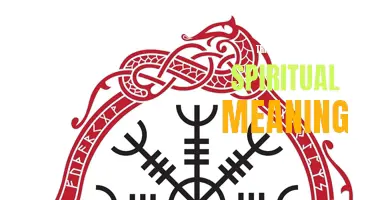
Faith symbols have been ingrained in human culture for thousands of years, serving as visual representations of our deepest beliefs and spiritual connections. From the cross in Christianity to the Star of David in Judaism, these symbols carry profound meanings that evoke a sense of devotion, hope, and unity. They have the power to transcend language and cultural barriers, speaking to the universal human longing for something beyond ourselves. Join me as we delve into the fascinating world of faith symbols and uncover the profound meanings they hold for believers around the globe.
What You'll Learn
- What are some common symbols of faith found in various religions?
- How do faith symbols convey meaning and represent beliefs?
- Are there any universal symbols of faith that are recognized across different religions?
- What is the significance behind specific symbols used in Christianity, Islam, Buddhism, etc.?
- How do individuals and communities use faith symbols in their rituals and practices?

What are some common symbols of faith found in various religions?
Faith is a central aspect of many religions. It represents belief, trust, and devotion towards higher powers or spiritual principles. As such, various religions have adopted specific symbols to represent and express their faith. These symbols serve as reminders, markers, and objects of contemplation for followers. Here are some common symbols of faith found in various religions:
- Cross (Christianity): The cross is one of the most recognizable symbols of faith, representing the crucifixion of Jesus Christ in Christian belief. It is a symbol of sacrifice, redemption, and resurrection.
- Star and Crescent (Islam): The star and crescent symbol is often associated with Islam and represents faith and guidance. It has historic connections with the Ottoman Empire and is used today to represent various aspects of Islamic faith, including the moon as a symbol of the Islamic calendar.
- Om (Hinduism): Om is a sacred sound and a symbol in Hinduism. It represents the ultimate reality and the underlying essence of the universe. It signifies the three aspects of God – creation, preservation, and destruction – and is chanted during religious rituals and meditations.
- Menorah (Judaism): The menorah is a seven-branched candelabrum and a symbol of Judaism. It represents the seven days of creation and is often lit during the festival of Hanukkah to commemorate the miracle of the oil.
- Dharmachakra (Buddhism): The dharmachakra, also known as the wheel of dharma, is a symbol in Buddhism. It represents the Buddha's teachings and the path to enlightenment. The wheel is often depicted with eight spokes, representing the Noble Eightfold Path.
- Yin and Yang (Taoism): The yin and yang symbol is a fundamental concept of Taoism. It represents the belief in the interconnectedness of opposites and harmony in the universe. It symbolizes balance, with the dark and light halves representing complementary forces.
- Aum or Omkar (Sikhism): Aum or Omkar is a symbol in Sikhism, similar to its usage in Hinduism. It represents the ultimate reality and the connection between the individual soul and the divine. It is chanted as a mantra in Sikh prayers and meditations.
- Ankh (Ancient Egyptian Religion): The ankh is an ancient Egyptian symbol for life. It represents eternal life, both in the physical and spiritual realms. The symbol is often held by gods and goddesses in ancient Egyptian art.
- Swastika (Various Religions): The swastika is an ancient symbol found in various religious traditions, including Hinduism, Buddhism, and Jainism. In these traditions, it symbolizes good luck, auspiciousness, and well-being. However, due to its association with the Nazi regime, it is now seen as a symbol of hate and oppression.
These are just a few examples of the common symbols of faith found in various religions. Each symbol holds deep significance and represents the beliefs and values of the respective religions. They serve as reminders of faith, devotion, and spiritual teachings, fostering a sense of connection and identity among followers.
Exploring the Rich Symbolism and Meanings of Tlingit Art: A Closer Look at Ancient Tlingit Symbols
You may want to see also

How do faith symbols convey meaning and represent beliefs?
Faith symbols play a significant role in different religions and cultures around the world. They are used to convey meaning and represent the beliefs, values, and practices of a particular faith. These symbols can vary greatly in their form, ranging from simple geometric shapes to intricate and ornate designs.
One way in which faith symbols convey meaning is by representing important concepts or ideas within a particular faith tradition. For example, the cross is a symbol commonly associated with Christianity and represents the crucifixion and resurrection of Jesus Christ. In this context, the cross symbolizes sacrifice, redemption, and eternal life. Similarly, the Star of David is a symbol of Judaism and represents the unity of God's divine wisdom and presence.
In addition to representing concepts and ideas, faith symbols also serve as a visual reminder of one's faith and can be used as a means of identification and recognition amongst followers. For example, the crescent moon and star are recognized as symbols of Islam, and wearing or displaying them can signify a person's religious affiliation.
Faith symbols can also convey deeper spiritual meanings and invoke a sense of reverence and awe. For many believers, these symbols are seen as sacred and imbued with a divine presence. For example, the lotus flower is widely regarded as a symbol of purity and enlightenment in Buddhism. Its blooming petals represent the journey towards spiritual awakening and the transcendence of worldly attachments.
In addition to their visual representation, faith symbols can also be accompanied by rituals, prayers, and stories that further enhance their meaning and significance. These rituals and practices often involve the use of symbols in specific ways, such as lighting candles, offering prayers, or wearing specific attire. These actions reinforce the symbolic meaning of the faith symbol and help to create a deeper connection between the believer and their faith.
Furthermore, faith symbols can also serve as a means of communication between believers. They can be used to express shared values, beliefs, and experiences within a community. For example, the fish symbol (Ichthys) has long been used by Christians to identify themselves to one another, especially during times of persecution when openly professing the faith was dangerous.
In conclusion, faith symbols are powerful tools that convey meaning and represent the beliefs and values of a particular faith. They serve as visual reminders, vehicles of identification, and sources of spiritual inspiration. Through their use in rituals, stories, and community practices, faith symbols create a deeper connection between believers and their faith. Whether simple or intricate, these symbols possess a profound significance that helps to guide and unite followers in their spiritual journey.
Exploring the Hidden Meanings of Dutch Symbols: Unearthing the Cultural Significance
You may want to see also

Are there any universal symbols of faith that are recognized across different religions?
When it comes to religion, there are countless symbols that hold deep meaning for their respective faiths. These symbols often serve as a representation of the beliefs, values, and traditions of the religion they are associated with. However, are there any universal symbols of faith that are recognized across different religions? While it may be challenging to find symbols that are universally recognized, there are a few that hold significance across multiple faiths.
One such symbol is the circle, which often represents unity, eternity, and the cycle of life. In Hinduism, the mandala is a prominent symbol that is used for meditation and spiritual growth. It is a complex geometric design consisting of a circle within a square, symbolizing the universe and the idea of wholeness. Similarly, in Buddhism, the mandala is used for meditation and represents the universe and cosmic forces.
The lotus flower is another symbol that transcends religious boundaries. Found in Hinduism, Buddhism, and Jainism, the lotus is known for its ability to grow and bloom in muddy waters. It symbolizes purity, spiritual awakening, and the triumph over adversity. In each of these religions, the lotus is associated with enlightenment and represents the journey towards spiritual growth.
The symbol of a cross is widely recognized as a Christian symbol, representing the crucifixion and resurrection of Jesus Christ. However, the cross also holds symbolism in other religions. In Hinduism, the cross-like symbol known as the swastika represents good luck, prosperity, and the eternal universe. It is a sacred symbol used in religious ceremonies and is seen as a representation of divine energy.
The concept of light is also a universal symbol across religions. In Christianity, the light represents the presence of God, enlightenment, and spiritual purity. In Buddhism, light symbolizes wisdom and the awareness of the true nature of reality. In Hinduism, light is associated with divine illumination and is often used in religious rituals and ceremonies.
Another symbol that holds significance in various religions is the tree. In Christianity, the tree of life is mentioned in the Bible and symbolizes eternal life. In Buddhism, the Bodhi tree represents enlightenment and the place where Gautama Buddha achieved enlightenment. In Norse mythology, Yggdrasil is the tree of life that connects all realms of existence.
While these symbols may have different meanings and interpretations in each religion, they share common themes of spirituality, enlightenment, and the interconnectedness of all things. They serve as reminders of the universal aspects of faith and the shared human experience of seeking spiritual connection.
In conclusion, while it may be challenging to find symbols that are universally recognized across all religions, there are a few that hold significance in multiple faiths. The circle, lotus flower, cross, light, and tree are all symbols that transcend religious boundaries and represent common themes of spiritual growth and connection. Understanding the symbolism behind these universal symbols can help foster a greater appreciation and understanding of different religious traditions.
Exploring the Rich Symbolism and Meanings Behind Filipino Tribal Tattoos
You may want to see also

What is the significance behind specific symbols used in Christianity, Islam, Buddhism, etc.?
Symbols play a crucial role in religious traditions, including Christianity, Islam, Buddhism, and many others. These symbols carry deep meaning and profound significance for believers, serving as visual representations of important religious concepts, beliefs, and ideas. Understanding the symbolism behind these symbols can provide valuable insight into the teachings and practices of these religions.
In Christianity, various symbols are used to represent key aspects of the faith. The cross, for example, is one of the most recognizable symbols in Christianity. It represents the crucifixion of Jesus Christ and His sacrifice for the salvation of mankind. The fish symbol, or Ichthys, is another important symbol in Christianity, often used to represent Jesus and serve as a secret sign for early Christians during times of persecution.
Islam, the second-largest religion in the world, also has several symbols with significant meaning. The most prominent symbol is the crescent moon and star, which is often associated with Muslim communities. While not an official symbol of Islam, the crescent moon and star represent the three aspects of Islam: faith, prayer, and fasting. Another significant symbol in Islam is the color green, as it is associated with paradise and is often used to symbolize the religion as a whole.
Buddhism, a religion founded in ancient India, also uses symbols to convey its fundamental teachings. The most well-known symbol in Buddhism is the Dharma wheel, also known as the Wheel of Law. This symbol represents the Buddha's teachings and the path to enlightenment. The lotus flower is another important symbol in Buddhism, as it symbolizes purity and spiritual awakening.
In Hinduism, the Om symbol is perhaps one of the most widely recognized symbols. It represents the ultimate reality, often referred to as Brahman, and is considered sacred in Hinduism. The Swastika, although now widely associated with Nazism, is also an ancient Hindu symbol representing auspiciousness and good luck.
Symbols in religious traditions are not limited to these major world religions. Other faiths, such as Judaism, Sikhism, and Jainism, also carry their own distinctive symbols. The Star of David is a significant symbol in Judaism, representing the Jewish people and their connection to God. The Khanda symbol, consisting of a double-edged sword, represents the Sikh faith and its values of justice, spirituality, and righteousness. In Jainism, the symbol of a hand with the wheel signifies ahimsa (non-violence) and represents the holy ones who possess infinite knowledge.
Overall, the significance behind specific symbols used in various religions is multifaceted and deeply rooted in the core teachings and values of each tradition. These symbols serve as reminders of faith, provide a sense of identity, and act as visual representations of complex religious concepts. Understanding these symbols can foster a deeper appreciation and insight into the rich diversity of religious traditions around the world.
Understanding the Symbol Dayz Icon Meanings: A Guide for Players
You may want to see also

How do individuals and communities use faith symbols in their rituals and practices?
Faith symbols hold significant meaning for individuals and communities across various religious traditions. These symbols are used in rituals and practices to express and embody beliefs, convey spiritual messages, and foster a sense of connection and reverence. From the tiny cross worn around a Christian's neck to the majestic crescent moon atop a mosque, faith symbols are instrumental in affirming and strengthening religious identities.
In Christianity, the cross takes center stage as an essential faith symbol. It represents the crucifixion and resurrection of Jesus Christ, serving as a reminder of his sacrifice and the promise of salvation. Christians often wear a cross as a personal expression of faith and as a way to keep Christ close to their hearts. During religious services, the cross is prominently displayed in churches and is revered as a sacred symbol of God's love and Jesus' victory over death.
Similarly, the Star of David holds great importance in Judaism. It is a six-pointed star formed by two equilateral triangles, symbolizing the union of heaven and earth. The Star of David represents the Jewish people, their faith, and their connection to God. It is often used in religious rituals and ceremonies, displayed on synagogues, and worn as jewelry or on clothing to proudly showcase Jewish identity.
In Islam, the crescent moon is a prevalent faith symbol. It is closely associated with the faith's lunar calendar and marks the beginning and end of each month. The crescent moon represents the presence of Allah, reminding Muslims of His ever-watchful gaze over the world. It is prominently displayed on mosques, has a vital role in determining the timing of religious ceremonies, and is often seen on flags of Muslim-majority countries.
In Hinduism, the lotus flower is a sacred symbol of purity and enlightenment. The lotus emerges from the muddy waters, blossoming into a beautiful flower, representing the soul's journey towards spiritual awakening. The lotus is used in Hindu rituals, often depicted in artwork, and serves as an auspicious symbol in religious ceremonies. Additionally, the Om symbol, a sacred sound and a representation of the ultimate reality, is frequently used in Hindu practices as a mantra or a visual symbol to access deeper levels of consciousness.
Buddhism encompasses a multitude of faith symbols, each with its own unique significance. The Buddha statue represents the enlightened state of being and serves as an object of meditation and veneration. Prayer flags, adorned with mantras and images of deities, are hung to promote peace, compassion, and good fortune. The Dharma wheel symbolizes the teachings of Buddha and the path to enlightenment. These symbols play a vital role in Buddhist rituals, practices, and sacred spaces.
Faith symbols go beyond mere visual representations of beliefs; they hold deep spiritual and cultural value. They provide a tangible connection to the divine and act as a reminder of the ultimate truths and aspirations of the respective religious traditions. For individuals and communities, the use of these symbols in rituals and practices strengthens their faith, fosters a sense of belonging, and adds richness and beauty to their spiritual journeys.
Exploring the Deeper Meanings of Symbolic Jewelry: Unlocking the Secret Language of Adornment
You may want to see also
Frequently asked questions
The cross is the most widely recognized symbol of Christianity and represents the crucifixion of Jesus Christ. It serves as a reminder of his sacrifice and the redemption of humanity through his death and resurrection.
The Star of David, also known as the Magen David, is a prominent symbol in Judaism. It represents the identity of the Jewish people and the connection between God and His chosen nation. It is often seen as a sign of protection and the unity of the Jewish community.
The crescent moon and star are often associated with Islam and are commonly seen as symbols of the faith. The crescent moon represents the beginning and end of the Islamic lunar calendar, while the star symbolizes the light and guidance of Allah. However, it is important to note that these symbols are not universally accepted as official symbols of Islam.
The Om symbol, also spelled Aum, is a sacred sound and symbol in Hinduism. It represents the ultimate reality, the Brahman, and the essence of the universe. Chanting or meditating on the Om sound is believed to connect the individual soul with the cosmic soul, bringing peace, harmony, and spiritual enlightenment.







